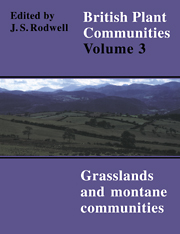Book contents
- Frontmatter
- Contents
- List of Figures
- Preface and Acknowledgements
- Preamble
- Mesotrophic Grasslands
- Community Descriptions
- Calcicolous Grasslands
- Community Descriptions
- Calcifugous Grasslands and Montane Communities
- Community Descriptions
- Index of Synonyms to Grasslands and Montane Communities
- Index of Species in Grasslands and Montane Communities
- Bibliography
U2 - Deschampsiaflexuosa Grassland
Published online by Cambridge University Press: 04 July 2020
- Frontmatter
- Contents
- List of Figures
- Preface and Acknowledgements
- Preamble
- Mesotrophic Grasslands
- Community Descriptions
- Calcicolous Grasslands
- Community Descriptions
- Calcifugous Grasslands and Montane Communities
- Community Descriptions
- Index of Synonyms to Grasslands and Montane Communities
- Index of Species in Grasslands and Montane Communities
- Bibliography
Summary
Synonymy
Graminetum arenosum Tansley 1911 p.p.; Nardus-Deschampsia grassland Adamson 1918 p.p.; Grassheath Tansley 1939, Pearsall 1968 p.p.; Deschampsia flexuosa grassland Tansley 1939.
Constant species
Calluna vulgaris, Deschampsia flexuosa.
Physiognomy
The Deschampsia flexuosa grassland comprises swards in which D. flexuosa is an obvious dominant, being particularly striking where the vegetation goes ungrazed in early summer, when an abundance of the tall silverypurple inflorescences can colour whole stands. In fact, the cover of the grass is rarely complete, and the height of its herbage is usually only around 2 dm, but its strongly tussocky habit and its ability to spread rhizomatously mean that it characteristically exerts a controlling effect on the distribution of many of the other species. This is visible, first, in the generally impoverished nature of the vegetation, in which there is but one other constant, hardly any other associates occurring commonly throughout and rather sparse preferential floras in the two sub-communities. And, second, although even occasionals of the community can sometimes show local prominence, there are no consistent patterns of coor sub-dominance.
In particular, other grasses and sub-shrubs are typically subordinate. Calluna vulgaris is the only other plant that occurs commonly overall, but it is characteristically found as sparse shoots and is sometimes absent altogether. And, although Vaccinium myrtillus and Empetrum nigrum ssp. nigrum are recorded fairly frequently, they are very much confined to one type of Deschampsia grassland and even there are of low cover. So, though the community is often seen in close association with a variety of heaths throughout its range and grades into them structurally, the balance of dominance in typical stands helps distinguish the vegetation types. The separation from calcifuge scrub is usually clear, too, although Ulex europaeus and Rubus fruticosus agg. can both occur occasionally in small amounts.
As for grasses, the most frequent associates are those which form the basis of other fine calcifuge swards, with Festuca ovina and Agrostis capillaris both common, Anthoxanthum odoratum, Agrostis canina, A. stolonifera and Festuca rubra occurring more occasionally. But, again, these are rather unevenly distributed throughout the community and, although the first two in particular can be patchily abundant, they never rival the dominance of D. flexuosa except very locally.
- Type
- Chapter
- Information
- British Plant Communities , pp. 317 - 323Publisher: Cambridge University PressPrint publication year: 1992

